Vietnamese Steamed Rice Cakes (Bánh Bèo)
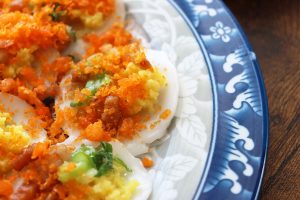
Vietnamese Steamed Rice Cakes, known as Bánh Bèo, are a popular dish originating from Huế, a city in Central Vietnam. These cakes are made from a mixture of rice flour and tapioca, steamed in small bowls, and topped with ingredients that typically include ground shrimp, mung bean paste, a mixture of green onion and oil, and fried pork lard. Like many other cakes in Vietnam, Bánh Bèo is accompanied by a prepared fish sauce, which enhances the overall flavour.
The term “Bánh” means “cake,” but what does “Bèo” refer to? “Bèo” describes the water ferns that float on rivers, a common sight in Vietnam. These ferns typically have a round shape, leading to the name “Bánh Bèo,” which could be translated as “Water Fern Cake” rather than just “Vietnamese Steamed Rice Cakes.”
When you visit Asian supermarkets or local food shops, you might find Bánh Bèo sold as a set of about ten cakes arranged on a white tray and wrapped in cling film. At Vietnamese restaurants, Bánh Bèo is usually presented flat together on a large dish. However, traditionally, each cake is served in its own small saucer dish, allowing diners to eat directly from that dish. So, if you order ten Bánh Bèo, you would have ten saucer dishes placed in front of you.
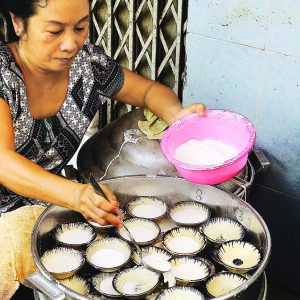
Some people may find this traditional way of serving Bánh Bèo a bit inconvenient. While that may be true, it highlights an important aspect of Huế’s culinary culture: everything is meant to be small, elegant, and retain an “imperial” look and feel, reflecting Huế’s status as the last imperial city of Vietnam. Today, although many restaurants and caterers present Bánh Bèo cakes on large trays for convenience, many places in Vietnam still adhere to the traditional serving method. To differentiate, these restaurants often add the term “Chén” after “Bánh Bèo,” which means “small bowl” or “saucer,” indicating that they serve Bánh Bèo in the traditional Huế style.
Regardless of how it’s served, Bánh Bèo is a delicious snack with a harmonious blend of flavours and textures. The cake itself is soft and slightly chewy, complemented by the sweetness of lightly fried ground shrimp, the pastiness of mung bean paste, the crunchiness of fried pork lard, and the aromatic flavour of green onions cooked in oil. When you dip a Bánh Bèo in fish sauce, it becomes so irresistible that you’ll find yourself reaching for another one!
Here are a few notes on my Vietnamese Steamed Rice Cakes (Bánh Bèo) recipe:
- To save time, I use ready-made Bánh Bèo flour (Kim Tự Tháp brand), which is available in most local Asian supermarkets.
-
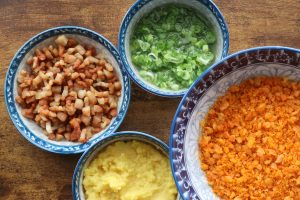
Typical toppings for Bánh Bèo For my Bánh Bèo, I include four toppings: dried ground shrimp, mung bean paste, a mixture of green onion and oil, and fried pork lard. While these toppings add delicious flavour, they can be a bit time-consuming to prepare. If you prefer, you can simplify the dish by reducing the number of toppings to two: dried ground shrimp and the green onion and oil mixture. Your Bánh Bèo will still be tasty and flavourful without the mung bean paste and fried pork lard. Alternatively, you can prepare some of the ingredients the day before, such as the dried ground shrimp, mung bean paste, and the dipping sauce.
- If you plan to serve Bánh Bèo in the traditional way – in saucers – make sure to have enough saucers on hand based on the number of guests and how many cakes each person will have. The most convenient option is to serve all the Bánh Bèo together on a large tray. However, even if you choose this route, have at least 10 saucers ready, as you’ll still need them for steaming the cakes.
- I highly recommend using annatto oil to enhance the colour of the fried dried shrimp. You can find my homemade recipe for this natural food colouring here.
- I highly recommend using a good-sized steamer that can hold at least 5-6 saucers. The larger the steamer, the less time you’ll need to steam in batches.
Q&As on Vietnamese Steamed Rice Cakes
1. Can I use fresh shrimp instead of dried shrimp?
Yes, you can definitely use fresh shrimp in place of dried shrimp! However, you’ll need to follow the same preparation steps. First, finely grind the fresh shrimp, either by hand or using a food processor. Then, lightly fry the ground shrimp until they dry out slightly. This will ensure that the fresh shrimp provides the right texture and flavour for your Bánh Bèo.
2. I don’t want to use fried pork lard, but I’d still like to add some crunchiness to my Bánh Bèo. Is there an alternative?
Yes, there is a great alternative! Many people cut up bread into small cubes, lightly fry them until crispy, and use these as a topping in place of fried pork lard. This not only adds a delightful crunch to your Bánh Bèo but also complements the other flavours beautifully.
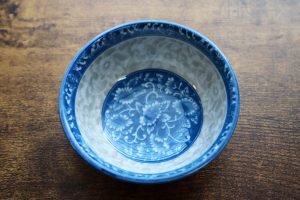
3. What saucer size is ideal for Bánh Bèo?
The ideal saucer size for Bánh Bèo is strictly a matter of personal preference. For my own preparation, I use saucers that are 3.25 inches in diameter and about 1.25 inches in depth. These saucers yield cakes that are 2.5 inches in diameter. If you decide to serve the cakes directly from the saucers, this size is ideal as it provides ample room for toppings and the prepared fish sauce that will be poured at serving time.
4. Can Bánh Bèo be made vegetarian?
Yes, it can! In fact, it’s quite easy to adapt the toppings for a vegetarian version: you can replace the shrimp with grated carrots, and substitute the pork fat with crispy bread cubes, as mentioned earlier. Additionally, the fish sauce can be replaced with a vegetarian soy-based sauce. I will be posting my recipe for vegetarian Bánh Bèo soon, so be sure to check back often!
5. Is Bánh Bèo a main course or an appetizer?
Bánh Bèo is typically considered an appetizer or a snack in Vietnamese cuisine. These delicate steamed rice cakes are often served as part of a larger meal or as a street food treat. While they can be enjoyed on their own, they are usually accompanied by dipping sauce and served alongside other dishes, making them a popular choice for sharing and sampling.
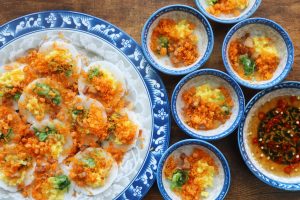
6. Is it difficult to make Bánh Bèo?
In general, no, making Bánh Bèo is not difficult. However, it may take longer compared to other dishes due to the number of ingredients and the preparation methods involved. For example, dried shrimp need to be soaked, drained, finely ground, and then lightly fried, which can add to the overall time. If you prefer, you can simplify the process by reducing the number of toppings or preparing some ingredients the day before. Alternatively, enlisting the help of another person can make the preparation more enjoyable and fun!
7. How do you pronounce “Bánh Bèo?”
“Bánh Bèo” is pronounced as “bahn beh-oh.” The “Bánh” sounds like “bahn,” with a rising tone, while “Bèo” is pronounced as “beh-oh,” where the “Bè” has a flat tone, followed by a short “oh.” This pronunciation captures the essence of the dish and reflects its Vietnamese roots.
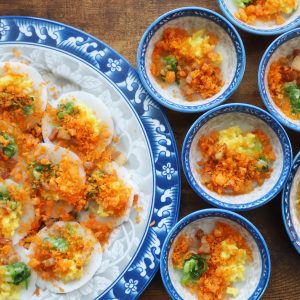
Recipe for Vietnamese Steamed Rice Cakes (Bánh Bèo)
Equipment
- 1 small pot
- 1 medium nonstick skillet
- 1 food processor
- 1 steamer
- 5+ saucers
Ingredients
- 340 grams flour for steamed rice cakes (Kim Tự Tháp brand)
- 175 grams dried shrimp
- 125 grams split mung beans
- 225 grams pork fat
- 65 grams green onions (finely chopped)
- ¼ cup vegetable oil
- 1 teaspoon annatto oil for colour optional
For Dipping Sauce:
- 2 tablespoons fish sauce
- 4 tablespoons water
- 3 tablespoons sugar
- 1 tablespoon lime juice
- 1 tablespoon fresh chilis (finely chopped)
Instructions
- Prepare the Dipping Sauce:In a bowl, mix together the fish sauce, water, sugar, lime juice, and chopped chilis until well combined. Stir until the sugar is fully dissolved, and the mixture is smooth. Set aside to allow the flavours to meld.
- Prepare the Toppings:Pork Fat:In a pot, bring water to a boil over medium-high heat. Once boiling, add the pork fat and blanch it for about 5 minutes.After blanching, remove the pork fat and rinse it under cold water to cool it down. If the pork fat includes skin, remove and discard it. Cut the pork fat into small cubes.In a medium skillet, add a small amount of water and bring it to medium-high heat. Add the pork fat cubes. Stir briefly to prevent sticking and to allow them to cook evenly.As the pork fat cooks, keep an eye on it. When it turns golden brown and crispy, remove it from the heat and place it in a strainer to drain excess oil. This step is crucial for achieving that delightful crunch.
- Mung Beans:Soak the split mung beans in warm water for about 30 minutes. After soaking, drain them thoroughly.In a small pot, add the mung beans and just enough water to cover them. Cook over medium heat without a lid, stirring occasionally to prevent sticking. The mung beans should become soft, which will take about 15-20 minutes.Once the mung beans are tender, remove them from the pot and transfer them to a fine mesh strainer. Allow the excess liquid to drain, and let the mung beans sit for a while so they can condense and firm up.
- Dried Shrimp:Soak the dried shrimp in warm water until softened, typically around 15-20 minutes. Drain them well after soaking.Finely grind the drained shrimp using a food processor until you achieve a fine texture. Heat a small nonstick skillet over low heat. Add a little oil to the pan, then stir-fry the ground shrimp until they dry out slightly.If using, stir in the annatto oil to add a beautiful colour to the shrimp. Mix well to combine, then remove from heat and set aside.
- Green Onions & Oil:In a small nonstick skillet, heat the vegetable oil over medium heat. Make sure the oil is hot but not smoking.Add the finely chopped green onions to the hot oil and stir until just cooked and fragrant, which should take about 1-2 minutes. Remove from heat and set aside to cool slightly.
- Prepare the Batter:In a large mixing bowl, combine the rice cake flour with 4 cups of warm water. Use a whisk or spatula to mix until smooth and free of lumps. This batter should have a pourable consistency.
- Steam the Cakes:Prepare several saucers by brushing the interiors with oil to prevent sticking. This will ensure that the cakes release easily after steaming.Prepare your steamer by filling it with water and bringing it to a gentle boil. Arrange the saucers inside the steamer.Pour 1 tablespoon of the batter into each oiled saucer.Cover the steamer with a lid and steam for about 7 minutes or until the cakes are set and slightly translucent.Carefully remove the saucers from the steamer using tongs or a kitchen cloth and allow them to cool slightly for 2 minutes. Then, use the tip of a knife to gently lift the cakes out and transfer them to a serving plate.Repeat the steaming process with the remaining batter.
- Serve:Spoon a small amount of mung bean paste, dried shrimp, crispy pork fat, and the oiled green onion over the top of each rice cake, creating a beautiful presentation.Your Vietnamese Steamed Rice Cakes (Bánh Bèo) are now ready to be enjoyed! Serve them warm with the prepared dipping sauce for a delightful treat.

